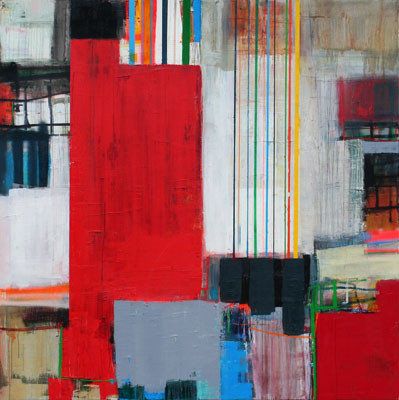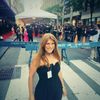
As Paul Klee the great abstract painter once said, "art does not reproduce what we see; rather, it makes us see." But how do we see things that seem otherwise intangible, even invisible? How can artists make them vivid for us on the canvas?
Such was the question that intrigued artist, Morten Lassen. The Danish abstract expressionist painter was fascinated by the concept of the digital age, especially as it intersects and coexisits with nature. "The organic or natural world has been around for millions of years, but the digital world is very new. They must somehow interfere with each other," says Lassen who has a global international following from Sydney to Hong Kong to Stockholm. Determined to express the feeling of how both worlds look together on canvass, Lassen devoted a series of abstract paintings in his new solo show, "A New World," at the Rebecca Hossack Art Gallery in New York City. The vibrant paintings combine colors and lines in unique and exciting arrangements.
I recently talked with Lassen about his life, art and inspiration.
Q: What was it about the digital and natural worlds that interested you so much?
Morten Lassen: The last five years I've been working on the concept of traffic. But it turned out to be more and more mental traffic - the kind of traffic that we can't see around us. But what's interesting for me are these two worlds meeting. In my paintings the thin lines express the new digital world. The {unstructured} sections that appear painted represent the organic world.
It's almost two kinds of painting with a meeting point between these styles. I find it interesting to have two different styles coming together and making a harmony or a disharmony or whatever happens. But they are very abstract. And because I'm an expressionistic and abstract painter, you can see whatever you want in them. I like to have a theme when I work for myself. But people can make their own ideas. Some people see architecture in my work and that's okay for me.
Q: In terms of your process, I know that you don't sketch first.
Morten Lassen: That's correct. I work on 15 or 20 paintings at the same time. I have a big studio. I only use oil paint so the paintings need time to dry. If I only painted on one canvass, I would be spending most of time waiting for it to get dry for the next layer. I sometimes need weeks between the layers. Some of the paintings have 25 layers. It's a long process.
The first many layers are just colors and combinations - what I know will disappear later in the process. But every layer is a starting point for the next layer. Because I work on many paintings they influence each other. I'll take parts from one work and think, this combination works well. I'll try that. Even though they are very individual paintings, somehow they will be connected. In the end, it's more like a puzzle.
Q: Your paintings are really feelings.
Morten Lassen: I'm not trying to paint how things look, like the meeting of these two worlds. I'm trying to express the feeling of how things could look. Think of when Kandinsky tried to paint music which is invisible. With his paintings you feel how music would look if we could see the music.
Q: And your pieces are minimal, yet complex.
Morten Lassen: I always believed that I had to get to a point where I actually felt deserving of being minimal in my expression and going in that direction. If you look at art history, many artists started out painting naturalistic images with landscapes. Then they get more and more focused and paint with not too many lines. You're telling the same story without taking everything.
Q: Ah. You're inspiring me to think of those early Picassos which are much more elaborate than the modernist Picassos most people know.
Morten Lassen: In the end it's just a horse with three lines. That's it.
Q: When did you feel you deserved to paint so minimally?
Morten Lassen: It's only in the recent years that I actually dared. But now I feel that my layering and my structure gives these layers a life so they get interesting, even though they are very monochronistic.
Q: Did you grow up seeing art?
Morten Lassen: My dad was very into art and took me to art shows and museums. I loved the Skagen painters from the European Golden Age who painted the light from the north, from beaches. In the summer we have these big fires on the beaches. And there was a specific painting with a big fire in the Skagens Musem. I remember as a small kid standing there thinking, wow, this is actually burning. I felt it was more than a painting and canvas. It did something special.
Q: What artists inspired you?
Morten Lassen: Per Kirkeby is one of our big Danish artists. He had a very Nordic aesthetic and worked with green-blue semi-abstract landscapes that were more abstract than landscape. It had a Nordic feeling to me. I was very influenced by him, especially when I began painting. I was not copying but I was into his painting style. He was my focus point especially when I had my first local show when I was around 17 or 18.
And Asger Jorn from the Cobra Movement is a very expressionistic, colorful painter. The Cobra movement had wild expressionistic paintings that didn't look like anything. It's just colors coming together. More than trying to describe a specific thing, it was about a feeling.
Q: When did you start to paint?
Morten Lassen: I always painted in school. When all my friends stopped, I just continued. I got very into it during high school and had an art teacher who was very good to me. He had a big budget for the whole class, but everybody skipped the class because we didn't get grades for art. So, he said, 'Morten, why don't we buy some big canvases and some expensive paint and just get going?' That was my starting point.
Q: What happened from there?
Morten Lassen: I moved to Copenhagen at 19 and got my first real studio. In Denmark big companies have art in the hallways for the employees to see. It's also a way to support young artists. I worked with a lot Danish brands like Bang & Olufsen and Lego. I would have my work hanging in these places and they would buy a work at the end of the month. Then I would move the exhibition to another company. That was how I started and got a bit of income and had money for materials. It was instant show. You're there for a month and then another artist takes over. I had a lot of shows and many people saw me because some of these companies have 2,000 or 3,000 employees. Suddenly people started buying my stuff.
Q: So what's next for you?
Morten Lassen: I'm working on a new series that will be called "Invisible." It's even more about the things we can't see. But I'm not finished with A Whole New World yet. As long as I think it's interesting and I will continue make paintings out of it. When I feel that I'm just reproducing myself I'll change.

(Photos used with permission.)
Paintings from Lassen's A Whole New World Series
To learn more about Morten Lassen and his work visit www.mortenlassen.com. For his exhibit at the Rebecca Hossack Art Gallery go to, www.r-h-g.co.uk

